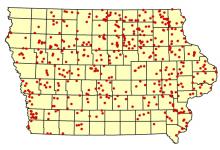Iowa Statewide Rural Well Water Survey Phase 2 (SWRL2)
The Iowa Statewide Rural Well Water Survey Phase 2 (SWRL2) was conducted from 2006-2008. It served as a follow-up study to the original SWRL (1988-1989).
SWRL2 study objectives were to examine trends in water quality since 1988–89 and collect baseline data for emerging contaminants. 473 private rural drinking water wells were sampled in 89 Iowa counties. 116 of the wells were original SWRL study wells; the other wells were randomly selected from the Iowa Department of Natural Resources Private Well Tracking System.

SWRL 2 well sampling sites
Findings from all of the sampled wells include:
Bacteria: 43% had total coliform bacteria, 19% had enterococci, 11% had E. coli
Nitrate: 49% had nitrate; 12% had ≥10 mg/L (parts per million) nitrate-N, EPA’s drinking water standard for public water supplies
Arsenic: 48% had arsenic; 8% had arsenic ≥0.01 mg/L, EPA’s drinking water standard for public water supplies
Pesticides (parent compounds): 8% had atrazine at very low concentrations; 2% had metolachlor; acetochlor, alachlor and trifluralin were detected in <1% of wells
Herbicide degradates (breakdown products of the parent compound): 11% had desethyl-atrazine, 11% had acetochlor ESA (ethane sulfonic acid), 27% had alachlor ESA, 33% had metolachlor ESA, and 8% had metolachlor OXA (oxanilic acid)
Health Assessment: This study did not set out to assess health risks associated with consumption of well water in Iowa. While some analysis showed levels of certain contaminants exceeding maximum contamination levels (MCLs) for public drinking water supplies, water quality in private drinking water wells is not regulated. Study-wide, no parent herbicide concentration was found to exceed a public water MCL. Herbicide degradate values were generally found at very small levels -- the mean for all degradates was 0.7 parts per billion (ppb) or less, with maximum values at 7 ppb. There are no established MCL values for degradates which are generally believed to be less toxic than their parent compound.
SWRL2 fact sheet and full report are available for download (PDF):